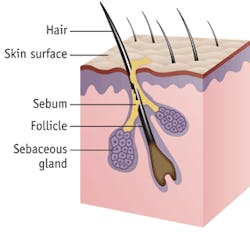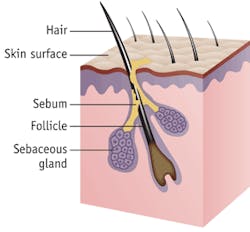Free-electron laser helps researchers find new ways to treat acne
Research fellow Fernanda Sakamoto, MD, of Harvard Medical School and her colleagues at the Wellman Center for Photomedicine at Massachusetts General Hospital (Boston) are using a tunable free-electron laser (FEL) at Thomas Jefferson Laboratories’ Free Electron Laser Facility (Newport News, VA) to study the principles of selective photothermolysis as a means of exciting vibrational modes of chemical bond of acne sebum molecules and thus developing more effective laser- and light-based acne treatments.
According to Sakamoto, 30% of acne sebum consists of fat, which contains an abundant amount of CH2 bonds. Earlier research demonstrated that laser light can selectively absorb CH2 bonds through chemical vibration absorption, as opposed to the traditional electronic absorption transitions. This novel approach of absorbing energy was at the center of the discovery of two wavelengths (1210 and 1720 nm) that are selectively absorbed more by fat than by water. Based on these findings, Sakamoto’s team decided to use the FEL, which can be tuned for various wavelengths and pulse durations, to target the sebaceous glands.
Sakamoto studied the effects on in vitro samples of prepared artificial sebum, human forehead skin, pig skin, and water. A thermal camera was used to determine where the sebaceous glands were located in the human and pig samples, as well as how much heat was absorbed by each sample at various wavelengths and pulse durations. In addition, tissue samples were stained for H&E to determine whether any hair follicles, epidermis, or collagen was damaged during the procedure. Nitrobluetetrazolium staining (NBTC) also was used to evaluate the viability of the skin after being irradiated by the laser, as well as the condition of the surrounding tissue. Sakamoto found in this preliminary study that more fat absorption of the human skin samples occurred at between 1700 and 1720 nm using about 100 to 125 ms pulse duration.
This research represents the first discovery of a wavelength that can specifically target the sebaceous glands, allowing for selective heating of their chemical-bond structures without damaging the surrounding epidermis or skin structures.
“While lasers and other light sources represent a growing field of research in treating acne, their results thus far are somewhat controversial,” said Dr. Sakamoto. “Until now, the light targeting acne is absorbed by water and only has a secondary effect on the sebaceous glands. Our research represents the first discovery of a wavelength that can specifically target the sebaceous glands, allowing for selective heating of their chemical-bond structures without damaging the surrounding epidermis or skin structures. That is what is particularly interesting about this concept because we are using a new wavelength that is not targeting the chromophores but the chemical bonds.”
Sakamoto’s research was honored at the 28th Annual Conference of the American Society for Laser Medicine and Surgery in April with the “Best Overall Basic Science Award.” Renowned laser pioneer R. Rox Anderson, MD, who is credited as the cofounder of selective photothermolysis, is also involved in this landmark research.
“These results are very encouraging, such that our next step is to conduct more research in vitro, trying different laser prototypes,” says Sakamoto. “While at this point we can’t be certain whether this technology will work for treating acne, we’re hopeful that further experiments will confirm our initial positive findings and bring us closer to defining optimal parameters for affecting human sebaceous glands in situ.”
Their findings so far suggest that 1700 to 1720 nm and 100 to 250 ms pulse duration show the most promise for this application, she adds. The researchers have already developed a prototype 1720 nm system for the next phase of clinical research, which should begin later this year. —KK

